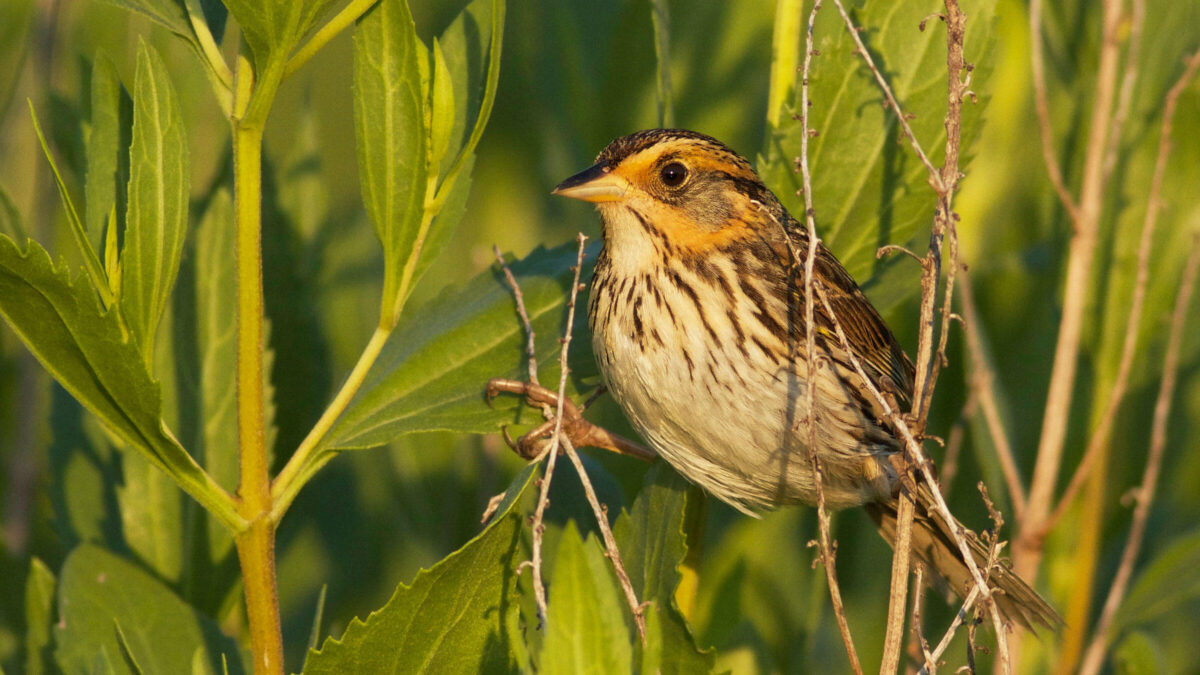Across the United States, coastal infrastructure poses ecological challenges to many habitat specialists, including the Saltmarsh Sparrow. The Saltmarsh Sparrow is a coastal passerine, or perching bird, that is endemic to the eastern coast of the U.S. These sparrows rely on salt marshes and high marsh ecosystems within wetlands for their breeding and brooding needs. Post-copulation, the female builds a nest of cordgrass in a part of the marshes that is only susceptible to flooding during storms and spring tide—a bi-monthly, lunar occurrence. In order to protect the eggs and chicks from being lost during inundation, the female will lay her eggs directly after a spring tide occurs. Additionally, the female builds the nest bowl of cordgrass to keep the eggs and chicks protected in the case of a flooding event. If successful, the eggs and chicks should sink down into the nest once the tide recedes, although there is no guarantee that they will survive the temperature of the water, especially if the eggs are nearing their hatch date.
In the 2020 Report on the Current Conditions of the Saltmarsh Sparrow, the U.S. Fish and Wildlife Service (FWS) states, “Based on surveys in 2012 the population was estimated at 60,000 individuals… Projecting those declines through 2020 we estimate that the current population is approximately 28,215 individuals. This represents a decline of 87 percent from the 212,000 individuals estimated in 1998.” Although this sparrow’s population has declined since the late 20th century, it was not until recently that it had experienced such a drastic reduction in numbers.
Coastal infrastructure disturbs the high marsh and wetlands, thereby indirectly impacting the Saltmarsh Sparrow populations due to the interconnectivity of these ecosystems. Tidal activity and marsh inundation both deposit sediments throughout salt marshes. This deposition leads to mineral and organic matter accumulation along with sediment accretion, subsequently promoting vegetation growth and heightening elevation.
Sediment deposition is particularly important in terms of marsh migration. As sea levels continue to rise, the marsh zones—mudflats, low marsh, and high marsh—begin to gradually move upland. The high marsh, in particular, relies on sediment deposition to maintain continued elevation growth. Without this sediment deposition and growth, the low marsh ecosystem might grow and overtake the former high marsh because the vegetation species cannot tolerate the amount of salt exposure that the lower ecosystem incurs. Without adequate sediment deposition and growth, the Saltmarsh Sparrows populations will be threatened due to loss of habitat.
Roads and manmade shoreline protectors, such as floodgates, jetties, and seawalls, act as tide suppressors that redirect tidal energy. This causes two major effects. The disruption of natural tides impacts the prior sediment deposition capabilities and, due to tidal redirection, can cause more substantial erosion of the nearby unprotected lands, which includes salt marshes.
Similarly, artificial shorelines located near salt marshes create tidal restrictions that can alter marsh composition and potentially increase the likelihood of nest floodings. Due to the nature of the sparrow’s nesting behavior, more frequent and severe nest flooding can significantly decrease the success of offspring rearing.
The sea-level rise impacting Saltmarsh Sparrows has also led to more frequent floods and higher maintenance costs for roads and bridges. In fact, the Atlantic Coast Joint Venture (ACJV) has revealed that “climate change is projected to increase the annual costs of keeping roads in service by $785 million by 2050.” A mutually beneficial solution would be for both new and existing transportation infrastructure to be built or altered to evade sensitive zones and avoid disturbing tidal cycles.
Promoting “marsh smart” systems into state and federal departments and organizations will preserve both salt marshes and coastal infrastructure. For example, if there is a mode of transportation that is currently in, or proposed to be constructed in, marsh areas and tidal zones, the structures can be built or rebuilt in ways that avoid disturbing the marsh hydrology. By being conscious of potential ecosystem impacts from the beginning, rather than being an afterthought, these actions will become a part of the system.
Likewise, enforcing further permitting requirements when developing near wetlands can reduce the risk of affecting the marshes. Stricter permitting will produce a more refined land-use planning process to evaluate potential marsh impacts. The ACJV encourages these changes because “environmental permits from local, state, and national agencies, [… along with] widespread implementation will require awareness and buy-in from a diversity of regulators and decision-makers.” Encouraging a system that integrates both infrastructure planners and scientists can ensure a higher degree of marsh safety. And, a remodeled infrastructure development process that considers the ecological needs of the environment will not only protect vulnerable species like the Saltmarsh Sparrow, but will also anticipate the adverse effects of climate change.
Sources
Salt Marsh Bird Conservation Plan for the Atlantic Coast. 2019. Atlantic Coast Joint Venture. www.acjv.org
Tiner, R.W. 2013. Tidal wetlands primer: an introduction to their ecology, natural history, status, and conservation. University of Massachusetts Press, Amherst and Boston. 508 pp.
U.S. Fish and Wildlife Service. 2020. Report on the current conditions for the saltmarsh sparrow. U.S. Fish and Wildlife Service, Northeast Region, Charlestown, RI. 106 pp. https://fws.gov/northeast/saltmarsh-sparrow/PDF/20200821-Current-Conditions-Report_SALS-Final.pdf
Featured image from https://www.audubon.org/news/the-saltmarsh-sparrow-creeping-dangerously-close-extinction

